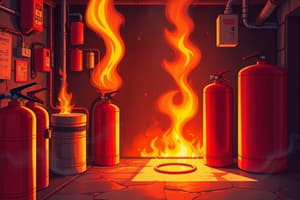Podcast
Questions and Answers
What is ammonium phosphate?
What is ammonium phosphate?
- The salt of ammonium and phosphate (correct)
- A type of foam
- A type of combustible material
- A fire extinguishing agent
What does Aqueous Film Forming Foam (AFFF) do?
What does Aqueous Film Forming Foam (AFFF) do?
Used for fire suppression, prevents the fire's contact with oxygen, forming a film over the liquid.
Carbon dioxide fire extinguishers are effective on Class A fires.
Carbon dioxide fire extinguishers are effective on Class A fires.
False (B)
What type of fires is a Cartridge/Cylinder fire extinguisher effective on?
What type of fires is a Cartridge/Cylinder fire extinguisher effective on?
What are Class A fires defined as?
What are Class A fires defined as?
Class B fires involve what?
Class B fires involve what?
What does a Class C fire involve?
What does a Class C fire involve?
What types of materials are involved in Class D fires?
What types of materials are involved in Class D fires?
What is a Class K fire?
What is a Class K fire?
What is a clean agent?
What is a clean agent?
What is a cylinder in the context of fire extinguishers?
What is a cylinder in the context of fire extinguishers?
What does a dry chemical fire extinguisher use?
What does a dry chemical fire extinguisher use?
What kind of fires does a dry powder fire extinguisher extinguish?
What kind of fires does a dry powder fire extinguisher extinguish?
What is referred to as the fire load?
What is referred to as the fire load?
What is hydrostatic testing?
What is hydrostatic testing?
Define ignition point.
Define ignition point.
What is an incipient stage fire?
What is an incipient stage fire?
What are light (low) hazard locations?
What are light (low) hazard locations?
Flashcards are hidden until you start studying
Study Notes
Fire Extinguishing Agents and Classes
- Ammonium Phosphate: A salt compound used as a fire extinguishing agent, commonly effective against Class A fires.
- Aqueous Film Forming Foam (AFFF): A fire suppression agent that forms a film to block oxygen, effective on various flammable liquids.
- Carbon Dioxide (CO2) Fire Extinguishers: Remove oxygen and heat; effective on Class B (flammable liquids) and Class C (electrical) fires, but not on Class A (ordinary combustibles).
- Cartridge/Cylinder Fire Extinguishers: Operate using cartridges, disrupting the fire triangle and effective on Class A, B, and C fires.
Classifications of Fires
- Class A Fires: Involve ordinary combustibles like wood, fabric, paper, and plastics—extinguished primarily using water or monoammonium phosphate.
- Class B Fires: Comprised of flammable or combustible liquids.
- Class C Fires: Involve energized electrical equipment, requiring appropriate extinguishing agents that do not conduct electricity.
- Class D Fires: Involve combustible metals such as magnesium and sodium; require specialized extinguishing agents.
- Class K Fires: Occur in cooking appliances, involving combustible cooking media (oils and fats).
Specific Extinguishing Agents and Their Characteristics
- Clean Agent: Electrically non-conducting agent that leaves no residue; used where sensitive equipment is involved.
- Dry Chemical Fire Extinguishers: Utilize powdered agents like sodium bicarbonate and ammonium phosphate to smother flames.
- Dry Powder Fire Extinguishers: Specifically designed for Class D fires, utilizing powdered extinguishing agents to smother and crust over the fire.
- Film-Forming Fluoroprotein (FFFP) Foam: A protein-based foam that creates a vapor-suppressing film on hydrocarbon surfaces.
Testing and Regulations
- Hydrostatic Testing: A method for testing the integrity of pressurized vessels, ensuring they can hold pressure without leaks.
- Fire Load: Refers to the total weight of combustible materials present in a given area, impacting fire risk assessments.
Fire Encyclopedia Terms
- Ignition Point: The minimum temperature required for combustible materials to ignite when exposed to a flame.
- Incipient Stage: The initial phase of a fire that can typically be controlled by portable fire extinguishers.
- Extra (High) Hazard Locations: Areas with significant amounts of Class A materials or rapidly flammable Class II combustibles, leading to high heat release rates.
- Light (Low) Hazard Locations: Spaces characterized by low quantities and combustibility of Class C materials.
Studying That Suits You
Use AI to generate personalized quizzes and flashcards to suit your learning preferences.



